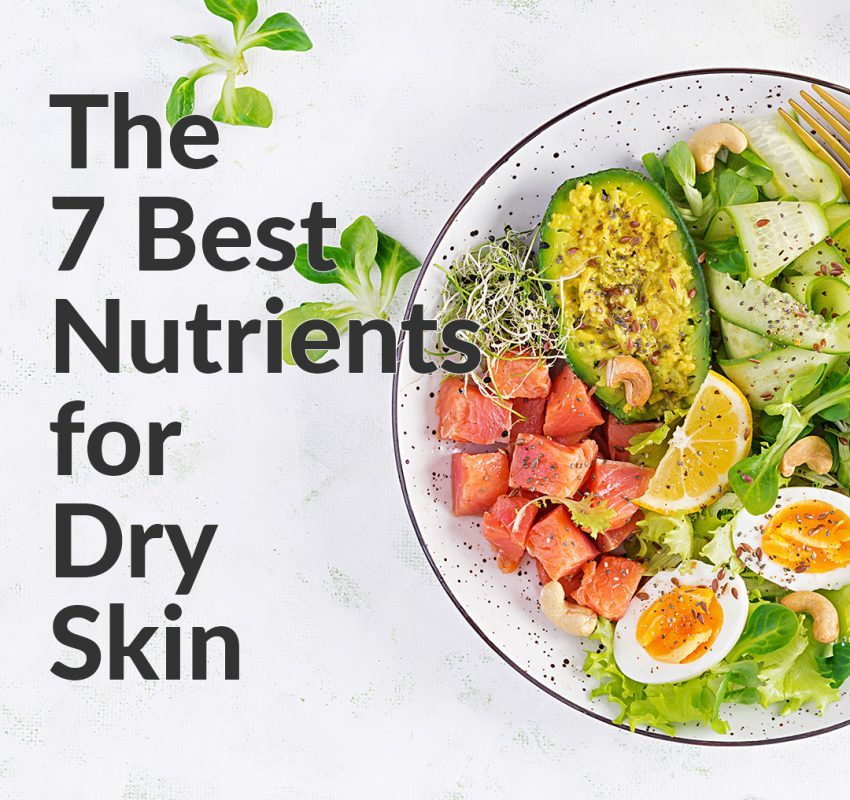
According to ecologyskincare dry skin needs to be hydrating in diffrent ways:
Dry skin has many different causes.
From our age and genetics to our hormonal fluctuations, medications, skincare regime and even the weather.
A lot of these factors that cause dry skin affect our skin’s protective barrier function.
If we have dry or damaged skin, in most cases it’s because our skin’s barrier function is weakened or damaged.
A weakened or damaged barrier function can even cause skin to look more wrinkled or ‘aged’ than it really is …and for fine lines to be more visible.
What is our skin’s barrier function?
Our skin cells are like bricks.
And in between our skin cells, sits a ‘glue or mortar’ made up of cholesterol, fatty acids and ceramides.
…it works like a living wall that keeps moisture in and allergens, microbes and irritants out.
(which is super important for keeping our skin healthy, soft and supple)
This collection of saturated fatty acids, cholesterol and ceramides is what’s known as our ‘skin’s barrier function’.
If we’re missing component’s of our skin’s barrier function or if they become damaged, we might notice our skin is dry, flaky, scaly, itchy and fine lines are more visible.
We can support our skin’s barrier function from the outside with skin care products.
(including our lipid-rich Ecology Creams)
But that’s only part of it… we can also support, strengthen and maintain our skin’s barrier function from the inside as well.
Here are the 7 nutrients most helpful for softening and smoothing dry skin from the inside out…
#1. ESSENTIAL FATTY ACIDS (OMEGA 3’S)

Making sure we’re eating enough good quality essential fats… is just as important as applying oils on top of the skin.
Why are Omega 3’s helpful for dry skin?
- If we’re not getting enough of these omega-3 fatty acids, the skin’s barrier function becomes weakened… leading to more moisture escaping from the skin and drier skin as a result
- Omega 3’s can also help increase skin’s moisture retention and firmness… improving the appearance of dry skin, acne, eczema and psoriasis.
- Taking in a balanced ratio of omega 3’s, 6’s and 9’s will have anti-inflammatory effects on the body and the skin. Unfortunately western diets with grains and vegetable oils tend to be higher in omega 6’s than 3’s.
- Increasing our intake of omega 3’s from oily fish may help with the balance of ‘good’ and ‘bad’ bacteria in the gut. And a happy gut equals happy skin.
Where can I find Omega 3’s?
Think ‘oily fish’, like…
- Salmon
- Mackerel
- Anchovy
- Sardines
- Herring
These are the ideal source of omega 3’s. The smaller the fish, the less likely it is to have high levels of mercury.
If you don’t like fish or you’re not having at least 2 servings a week… then it’s important to be taking an additional omega 3 supplement
Try:
Thinking beyond the ‘fish fillet’ when you’re looking to increase your intake of fish or seafood… give these a go:
- Salmon and sweet potato patties
- Tinned mackerel in a stir fry
- Grilled fish tacos
- Sardines on GF toast or potato hash
#2. SATURATED FATS

Wait…what?
Why are saturated fats helpful for dry skin?
- Saturated fats make up the cell membranes of every single cell in our bodies… including our skin cells.
- They also help form our skin’s protective barrier function that helps keep moisture in the skin.
- Strong, healthy cell membranes contain a good amount of cholesterol and saturated fats. This helps our skin cells retain water. So skin cells are more likely to stay nice and plump, like grapes… rather than dehydrated like raisins.
- Interestingly, a Japanese study of 716 women found those who ate the most saturated fat had significantly less wrinkles and better skin elasticity.
Where can I find saturated fats from healthier sources?
Think traditional animal fats… and look for natural fats including:
- Grass-fed tallow
- Grass-fed ghee or butter
- Lard
- Avocado
- Coconut
- as well as foods that contain omega 3’s, like oily fish
Try:
- Sautéing veggies in grass-fed tallow or ghee
- Ghee fried eggs with avocado
- Coconut fish curry
- Slow cooking fattier cuts of grass-fed meat
- Adding avocado as a side ‘condiment’
- Adding avocado to a morning smoothie
#3. ZINC

Why is zinc helpful for dry skin?
- Zinc plays a role in maintaining skin’s structure and integrity. It’s found as an active component of at least 300 proteins in the body.
- When there’s a deficiency in zinc, it can weaken the structure of our skin’s barrier.
- There’s also the suggestion of a relationship between zinc and vitamin A… with zinc assisting vitamin A to do it’s job in the body.
Where can I find zinc?
- Oysters & mussels
- Mushrooms
- Grass fed meats
- Pumpkin seeds
- Yoghurt & kefir
- Soaked/sprouted legumes
- Crab & lobster
- Spinach
- Quinoa
- Raw cocoa
Try:
- Sprinkling pumpkin seeds on your cereal or salad
- Cooking quinoa with rice
- Spinach and mushroom omelette for breakfast
- Mussels with GF pasta or zucchini noodles
#4. VITAMIN A

Why is Vitamin A helpful for dry skin?
- Vitamin A is an important fat soluble nutrient needed for the creation and repair of skin cells. It also plays a role as an antioxidant in combating inflammation throughout the body.
- Vitamin A promotes cellular turnover in skin. It can slow down the breakdown of collagen and elastin and reduce the appearance of wrinkles
- One major sign of vitamin A deficiency is rough, dry and scaly skin
Where can I find Vitamin A?
Vitamin A (as Vitamin A) is only naturally found in animal food sources, in particular
- Liver, and
- Egg yolk
However, orange and red coloured fruits and vegetables contain provitamin A.
Our bodies have the ability to convert provitamin A to vitamin A in the body.
Supplementation of vitamin A can be dangerous if not under the guidance of a healthcare professional. But one great way to get a safe and effective dose of vitamin A is through the consumption of cod liver oil.
Try:
- traditional liver pate on GF crackers
- carrot and pumpkin soup
- sweet potato and egg muffins
- scrambled eggs with oregano
#5. VITAMIN E

Why is Vitamin E helpful for dry skin?
- Vitamin E is an abundant fat soluble antioxidant found in the skin
- It’s also an essential component of sebum (our naturally produced skin oils), which acts as the protective outer coating on the skin
Where can I find Vitamin E?
- Nuts & seeds
- Whole grains
- Cold pressed vegetable oils
- Dark green leafy vegetables
- Egg yolk
- Avocado
- Sweet potato…
Try:
- Snacking on a trail mix of nuts and seeds
- Avocado, eggs and rocket on GF toast with goats feta
- Using wheatgerm in your next soup, stew or casserole
#6. VITAMIN C

Why is Vitamin C helpful for dry skin?
- Vitamin C plays a crucial role in the regulation of collagen in the skin. Collagen is essential for the structure of the skin barrier itself
- One of the signs of scurvy (a condition of extreme vitamin C deficiency) is dry and rough skin
Where can I find Vitamin C?
Think colourful red, green, purple and orange foods in particular… as well as fermented vegetables.
This is why it’s important to include a rainbow of fruits and vegetables in your meals throughout your day.
Try:
- Kiwi, zucchini, spinach and raspberry smoothie
- Berries on your cereal
- Lemon juice dressing on salads
- Dips with carrots, capsicum and cucumber sticks
- A side of kimchi with your meal
#7. COLLAGEN

Why is collagen helpful for dry skin?
- Collagen is the most abundant protein in the body. It’s particularly important in providing structure within the skin
- As we age, our bodies naturally produce less collagen… resulting in a greater chance of developing dry skin and the formation of wrinkles
- Eating or drinking collagen boosts the body’s own collagen production, helping to smooth out fine lines and wrinkles and improve skin elasticity
- As mentioned above, collagen and vitamin C are a power duo. Vitamin C helps provide the foundations for collagen to build upon
- Collagen also has a key partnership with water. Collagen acts like a sponge. So the more hydrated someone is while taking collagen… the greater effectiveness the collagen will have with ‘plumping up’ the the skin.
Where can I find collagen?
Think bone broth (chicken, beef, fish) and soups or stews made with the bones or connective tissue in them (even if the bones are later removed)
You can also get collagen in powdered gelatin and collagen supplements
Try:
- Using bone broth instead of stock in your next soup or stew,
- Osso bucco
- Making a curry or stew with chuck steak
If this feels like a lot to remember, don’t worry we’ve got a handy graphic below to help… and if all else fails, it’s helpful to remember to ‘eat a rainbow’ of fruits and veggies

What makes colourful Fruit and Veggies helpful for dry skin?
Fruits and veggies contain lots of fibre, vitamins and minerals that are essential for skin health. They also contain water for bonus hydration!
(remember water is helpful for collagen’s ‘plumping’ effect in the skin)
Try:
Challenging yourself to eat every colour of the rainbow during your day. We eat with our eyes, so having a plate full of vibrant colours is a lot more appealing to our body and to our brain.

BONUS KEY FACTOR = GUT HEALTH

As always, gut health has an important relationship with our skin health.
If our gut isn’t happy, we won’t be absorbing all those lovely nutrients that we’re eating.
I love the saying… “you’re not what you eat, you’re what you digest and absorb” …and it’s so true!
Some people have digestive issues with absorbing fats… and as you’re now aware we need natural fats to help our skin maintain moisture levels
If you sometimes experience:
- Nausea
- Abdominal pain or bloating
- Explosive diarrhoea
- Fluid retention
- Stools that are light in colour and float or stick to the bowl
…it would be worth having a chat with a Naturopath or health care professional about your gut health.
Wishing you silky smooth skin!








1 thought on “SKIN: The 7 Best Nutrients for Hydrating Dry Skin from the Inside Out”
Pingback: Rosacea: The 5 Worst Trigger Foods For Aggravating Rosacea Prone Skin